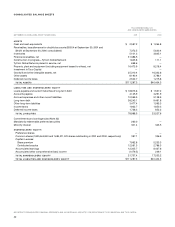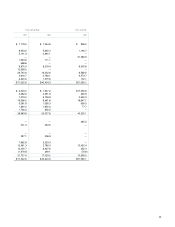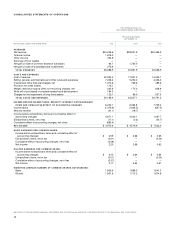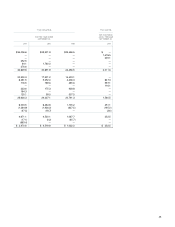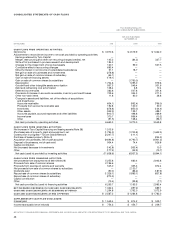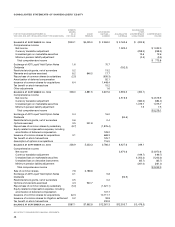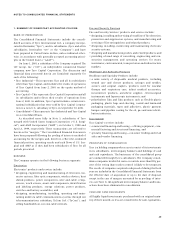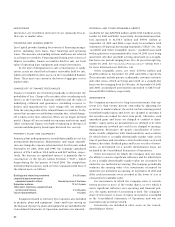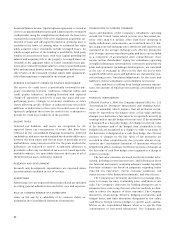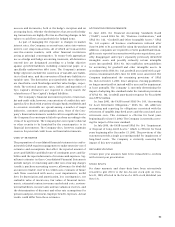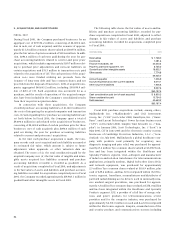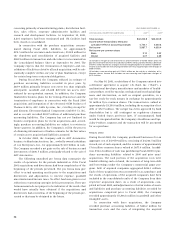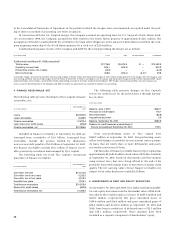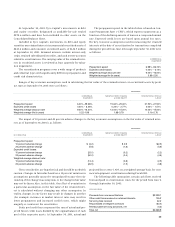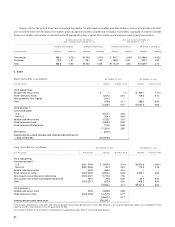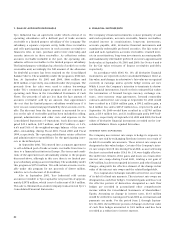ADT 2001 Annual Report Download - page 54
Download and view the complete annual report
Please find page 54 of the 2001 ADT annual report below. You can navigate through the pages in the report by either clicking on the pages listed below, or by using the keyword search tool below to find specific information within the annual report.
52
unearned finance income. Operating lease equipment is carried at
cost less accumulated depreciation and is depreciated to estimated
residual value using the straight-line method over the lease term
or projected economic life of the asset. Equipment acquired in sat-
isfaction of loans and subsequently placed on operating lease is
recorded at the lower of carrying value or estimated fair value
when acquired. Lease receivables include leveraged leases, for
which a major portion of the funding is provided by third party
lenders on a nonrecourse basis, with Tyco Capital providing the
balance and acquiring title to the property. Leveraged leases are
recorded at the aggregate value of future minimum lease pay-
ments plus estimated residual value, less nonrecourse third-party
debt and unearned finance income. Management performs peri-
odic reviews of the estimated residual values with impairment,
other than temporary, recognized in the current period.
RESERVE FOR CREDIT LOSSES ON FINANCE RECEIVABLES
The reserve for credit losses is periodically reviewed for ade-
quacy considering economic conditions, collateral values and
credit quality indicators, including historical and expected
charge-off experience and levels of past due loans and non-
performing assets. Changes in economic conditions or other
events affecting specific obligors or industries may necessitate
additions or deductions to the reserve for credit losses. In man-
agement’s judgment the reserve for credit losses is adequate to
provide for credit losses inherent in the portfolio.
INCOME TAXES
Deferred tax liabilities and assets are recognized for the
expected future tax consequences of events that have been
reflected in the Consolidated Financial Statements. Deferred
tax liabilities and assets are determined based on the differences
between the book values and the tax bases of particular assets
and liabilities, using tax rates in effect for the years in which the
differences are expected to reverse. A valuation allowance is
provided to offset any net deferred tax assets if, based upon the
available evidence, it is more likely than not that some or all of
the deferred tax assets will not be realized.
RESEARCH AND DEVELOPMENT
Research and development expenditures are expensed when
incurred and are included in cost of revenue.
ADVERTISING
Advertising costs are expensed when incurred and are included
in selling, general, administrative and other costs and expenses.
SALE OF COMMON SHARES OF A SUBSIDIARY
Gains on the sale by a subsidiary of its common shares are
included in the Consolidated Statement of Operations.
TRANSLATION OF FOREIGN CURRENCY
Assets and liabilities of the Company’s subsidiaries operating
outside the United States which account in a functional cur-
rency other than U.S. dollars, other than those operating in
highly inflationary environments, are translated into U.S. dol-
lars using year-end exchange rates. Revenues and expenses are
translated at the average exchange rates effective during the
year. Foreign currency translation gains and losses are included
as a component of accumulated other comprehensive (loss)
income within shareholders’ equity. For subsidiaries operating
in highly inflationary environments, inventories and property,
plant and equipment, including related expenses, are translated
at the rate of exchange in effect on the date the assets were
acquired, while other assets and liabilities are translated at year-
end exchange rates. Translation adjustments for the assets and
liabilities of these subsidiaries are included in net income.
Gains and losses resulting from foreign currency transac-
tions, the amounts of which are not material, are included in net
income.
FINANCIAL INSTRUMENTS
Effective October 1, 2000, the Company adopted SFAS No. 133,
“Accounting for Derivative Instruments and Hedging Activi-
ties,” as amended, which requires that all derivative instru-
ments be reported on the balance sheet at fair value and that
changes in a derivative’s fair value be recognized currently in
earnings unless specific hedge criteria are met. If the derivative
is designated as a fair value hedge, the changes in the fair value
of the derivative and of the hedged item attributable to the
hedged risk are recognized as a charge or credit to earnings. If
the derivative is designated as a cash flow hedge, the effective
portions of changes in the fair value of the derivative are
recorded in other comprehensive (loss) income and are recog-
nized in the Consolidated Statement of Operations when the
hedged item affects earnings. Ineffective portions of changes in
the fair value of cash flow hedges are recognized as a charge or
credit to earnings.
The fair value estimates are based on relevant market infor-
mation, including current interest rates, and information about
the financial instrument, assuming adequate market liquidity.
Fair value estimates are based on judgments regarding future
expected loss experience, current economic conditions, risk
characteristics of the financial instruments, and other factors.
The Company uses derivative instruments to manage expo-
sures to foreign currency, commodity price, and interest rate
risks. The Company’s objectives for holding derivatives are to
minimize these risks using the most effective methods to elimi-
nate or reduce the impacts of these exposures. The Company
documents relationships between hedging instruments and
hedged items, and links derivatives designated as fair value,
cash flow or foreign currency hedges to specific assets and lia-
bilities on the Consolidated Balance Sheet or to specific firm
commitments or forecasted transactions. The Company also


